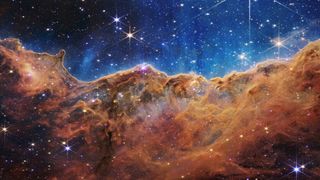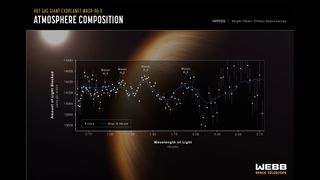Behold! The James Webb Space Telescope's stunning 1st science images are here.
The wait is finally over — for the photos and for all the research that will follow.
GREENBELT, Md. — The wait is finally over.
On Tuesday (July 12), NASA released some of the James Webb Space Telescope's first stunning images and data from during a live event. The four targets, including three images and a spectrum, capture the infrared universe in breathtaking detail. A fourth image, a sharply focused ultradeep field view, was unveiled on Monday (July 11) night by President Joe Biden during a live broadcast, revealing a universe older than we have ever seen. Together, the images and data represent the huge potential of the telescope to contribute to scientific research, and signal Webb's transition into an active scientific instrument.
"You know what I'm most excited about?" Thomas Zurbuchen, NASA's associate administrator for science, said during the event after the images were revealed. "There's tens of thousands of scientists — and frankly, some of them just got born or are not even born — who are benefiting from this amazing telescope because it will be with us for decades."
Gallery: James Webb Space Telescope's 1st photos
Live updates: NASA's James Webb Space Telescope mission

The three images released during today's event show the Carina and Southern Ring Nebulas, as well as a group of galaxies called Stephan's Quintet. The fourth target is the spectrum of a gas giant exoplanet called WASP-96 b.
The Carina Nebula, one of the brightest and largest nebulas in the sky, is 7,600 light-years away from Earth. Spanning over 300 light-years across, it includes Eta Carinae, a dying supergiant star on the brink of a massive explosion, as well as Trumper 14, one of the youngest known clusters of star formation. A nebula is a stellar nursery, and Carina is a sprawling, active and sometimes violent one.
"There's so much going on here, it's so beautiful," Amber Straughn, an astrophysicist at NASA's Goddard Space Flight Center in Maryland, said. "This stunning vista of the cosmic cliff of the Carina Nebula reveals new details about this vast stellar nursery. Today, for the first time, we're seeing brand new stars that were previously completely hidden from our view."
Get the Space.com Newsletter
Breaking space news, the latest updates on rocket launches, skywatching events and more!

In contrast, The Southern Ring Nebula is closer to Earth — a mere 2,000 light-years away. It is a planetary nebula, or an expanding cloud of gas surrounding a dying star. Having blown off all its outer layers, the dying white dwarf star at the nebula's heart is unimaginably hot and releasing intense ultraviolet radiation, causing the gas around it to light up.
The new images show the shells formed by that gas, Karl Gordon, an astronomer at the Space Telescope Science Institute, said during the event, as well as patches in the nebula where starlight shines through.
"As we go into the center, we see kind of the surprise for us, which is — we knew this was a binary star, but we effectively didn't really see much of the actual star that produced the nebula, but now in MIRI, this star glows red because it has dust around it, so in MIRI, we got to see both stars very clearly," he added.
Stephan's Quintet is a group of five galaxies that appear preposterously close together, about 290 million light-years away from Earth. Four of the galaxies are locked in a sort of cosmic dance that will one day result in the quartet colliding, and three sport elongated, spiral-like shapes from their interactions. The stars in the quintet run the gamut from newborn to ancient, spanning hundreds of millions of years of cosmic history.
"This is a very important image and area to study because it really shows the type of interaction that drives the evolution of galaxies," Giovanna Giardino, an astronomer at the European Space Agency, said.

The final piece of Webb's first public science results wasn't an image at all, but a spectrum — a representation of the amount of different wavelengths of light emitted by an exoplanet dubbed WASP-96 b. The gas giant world, about half the size of Jupiter, is the closest of the newly revealed objects, at about 1,150 light-years away. It orbits its star every 3.4 days, and has a unique, cloudless atmosphere made largely of sodium.
The only known cloudless planet, WASP-96 b has been an enigma and a prime target for further study since its discovery in 2013. And Webb's new data offers scientists more data than ever before about that strange atmosphere.
"We've been able to use other telescopes to explore exoplanet atmospheres in the infrared, but not to this level of detail," Knicole Colón, an astrophysicist at NASA's Goddard Space Flight Center in Maryland, said. "This is just one sliver of data that Webb is providing us, using the NIRISS instrument specifically."
"You get a bunch of what looks like bumps and wiggles to some people, but it's actually full of information," Colón said. "You're actually seeing bumps and wiggles that indicate the presence of water vapor in the atmosphere of this exoplanet."

The gorgeous new images follow seven months of painstaking deployment of the telescope since its launch on Dec. 25, 2021. In turn, launch was the culmination of over two decades of development, starting in 1996, and general discussion about the project that began even earlier. Over the years, Webb was sometimes severely strapped for funding, and at least once was in danger of being canceled due to soaring costs.
Despite the rocky road, with Webb now safe in space, scientists say that the now functional telescope, which is performing better than expected in almost every way, should be able to operate for the next two decades.
"I'm thrilled and I'm relieved," John Mather, an astrophysicist at Goddard and senior project scientist for Webb, said. "When you start something this big, you know, there's always a possibility it might not work. It did work. We are so proud."
Developing the telescope was a collaborative effort between NASA, the European Space Agency and the Canadian Space Agency, with scientists working together across agencies and across divisions within agencies, all contributing in unique ways to the vast project.
Canada's Near-Infrared Imager and Slitless Spectrograph (NIRISS) instrument, for instance, gathered the spectral data of WASP-96 b, and throughout the telescope's tenure will allow Webb to make key observations of distant galaxies and exoplanets.

Though people often imagine only one mission control room for any given space mission, Webb has several teams managing it from different locations, and representatives from each agency helped choose Webb's first images.
JWST is named after former NASA administrator James Webb, who led the agency during the Apollo moon missions in the 1960s. Although the mission was named in the early 2000s, as the telescope's launch approached, people have objected to honoring Webb. They argue that during his time in federal government, Webb actively supported or passively permitted the so-called "Lavender Scare" — the widespread discrimination again LGBTQ+ government employees at the time.
Leading up to the release of the first images, some astronomers have expressed mixed emotions on Twitter, as excitement for the new data and dislike of the name mingle. NASA officials have not discussed the name of the observatory since the spring, when officials said that research into Webb's role in the Lavender Scare continued.
Regardless of what it is called, the telescope is set to make history. Its final instrument was cleared for science on Monday (July 11), hours before Biden unveiled the ultradeep field. Now that the space community has celebrated the beginning of the observatory's tenure, Webb will dive into its planned science observations, and scientists will also be able to analyze data from Webb's first targets right away.
Startling new insights could start to stream in quickly as research begins on every conceivable scale in our universe, from our solar system to the very first galaxies. Regardless of what we find, Webb scientists mark today as the start of a new era — one in which Webb will redefine what we know about our universe and how we think about our place within it.
"Every dot of light we see here is an individual star, not unlike our sun," Straughn said. "Our sun and our planets and ultimately us were formed out of the same type of stuff that we see here."
Follow us on Twitter @Spacedotcom and on Facebook.
Join our Space Forums to keep talking space on the latest missions, night sky and more! And if you have a news tip, correction or comment, let us know at: community@space.com.

Rebecca Sohn is a freelance science writer. She writes about a variety of science, health and environmental topics, and is particularly interested in how science impacts people's lives. She has been an intern at CalMatters and STAT, as well as a science fellow at Mashable. Rebecca, a native of the Boston area, studied English literature and minored in music at Skidmore College in Upstate New York and later studied science journalism at New York University.
